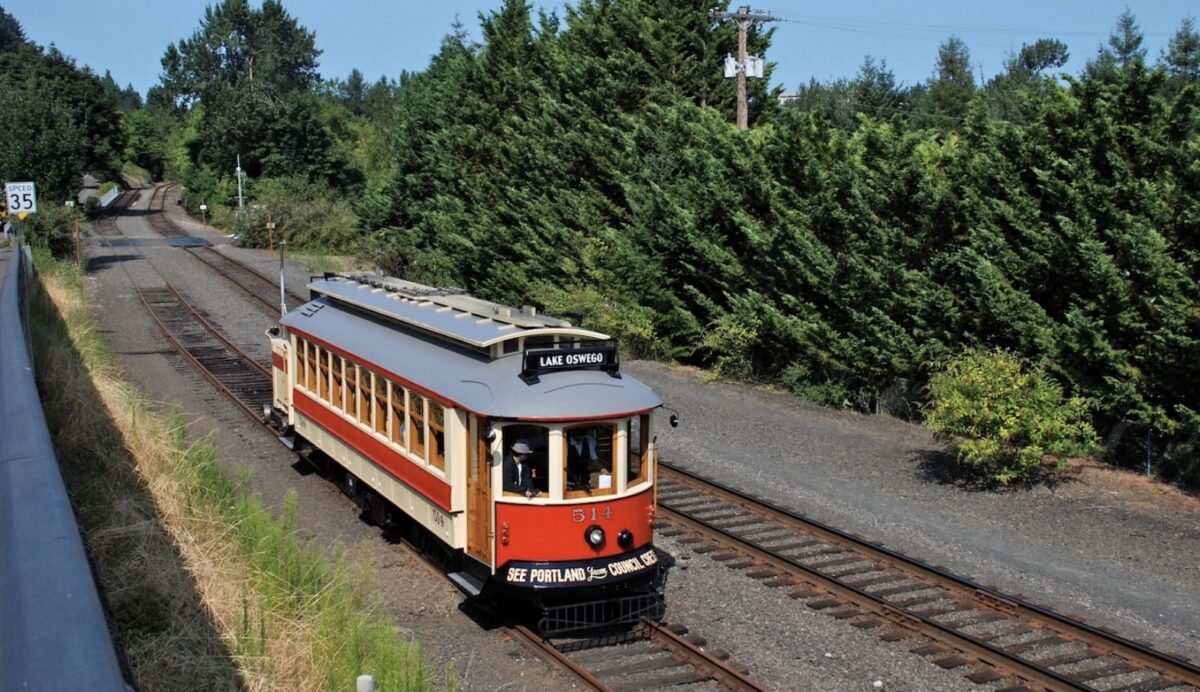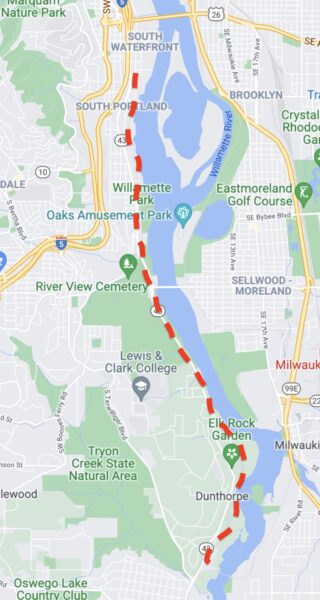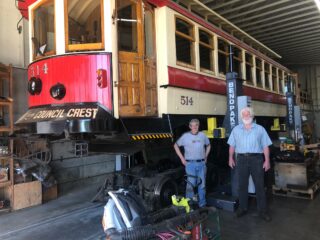
(Photo: Steve Morgan/Wikimedia Commons)
10 years after hopes for a new streetcar line to Lake Oswego were dashed, the Willamette Shore Trolley line is showing signs of new life. The line, which has very limited and seasonal service, takes passengers on a scenic excursion in a vintage replica trolley from Portland’s South Waterfront to Lake Oswego, and serves as a popular weekend outing for tourists and families.

(Photo: Jonathan Maus/BikePortland)
But advocates see this rail line as more than just a tourist activity. The Willamette Shore Trolley runs on a track built in the late 1800s that was used most often during the 1920s, when the old electric interurban rail system in the Willamette Valley served as the freeway. This short trip from Portland to Lake Oswego represents a dream of revitalized train travel in the Pacific Northwest as an alternative to highway expansion and many bike lovers haven’t given up on the dream of an adjacent bike path.
“We had an incredible network of rail service and it’s all gone,” says Rick Gustafson, veteran rail advocate, former director of Portland Streetcar and current president of Vintage Trolley Incorporated, the company that owns the trolleys.
But Gustafson and Dave Rowe, the WST’s superintendent of vehicle maintenance, see the golden era of Oregon’s intercity transit as something that could happen again.
“A million-and-a-half passengers moved by rail in Oregon annually back then. You could ride rail anywhere up and down the Willamette Valley,” Rowe says. “The Willamette Shore Trolley is a short line, but the idea is that the rail right-of-way is still there.”
“America is so far behind. I wish that we’d get our politicians to look at this so we could fund it.”
— Dave Rowe, Willamette Shore Trolley
In the 1980s, after passenger rail hadn’t been running on this line for decades, a consortium of public entities that included the City of Portland, the City of Lake Oswego and TriMet purchased the right-of-way to the track that the Willamette Shores Trolley runs on. This secured the line the seasonal excursion and for potential future use.
Unfortunately damaged trestle bridges have forced the trolley to run only on the southern portion of its track, from just north of Lake Oswego to the Elk Rock tunnel. Rowe and others with WST are hopeful that money from Biden Infrastructure Investment and Jobs Act will go toward these repairs so service can be re-established all the way to South Waterfront in Portland.
It will take a minimum of $800,000 to update the trestles to necessary safety standards, restoring the full route and bringing it back to its status as a unique tourist attraction and important piece of rail preservation that could herald future mass transit.
Advertisement

Since the line the WST runs on is so old and needs so many repairs, some advocates have proposed establishing a bike and pedestrian path over the railroad tracks. This has long been a dream of regional bike advocates. In 2006 The Street Trust (then Bicycle Transportation Alliance) made a Portland to Lake Oswego bike path one of their top priorities. In 2015, the Lake Oswego City Council revived the concept of a bike path along the trolley right-of-way. A bikeway running alongside the tracks wouldn’t be feasible along the whole line, like in the narrow Elk Rock tunnel, so the route might have to detour onto roadway shoulders in certain spots.
If the WST doesn’t run passenger trains, part of the right-of-way will be given back to the property owners who live along the rail lines, making it much more difficult to restore any kind of commuter service between Lake Oswego and Portland in the future. Gustafson says retaining the right-of-way could provide opportunities for other solutions in the future that could accommodate both bike and trolley travel, and he sees the door open for further discussions on this down the line.
Rowe is also considering how to allow passengers to take bikes on the trolley, potentially by adding a bike rack that could serve as an alternative to a bikeway.
Meanwhile, Rowe has also been working on converting one of the diesel trolley cars to battery power, with hopes to electrify the whole system and a nod toward restoring the century-old legacy of the first battery-operated streetcar line in the Western U.S. This will make it more environmentally friendly, less expensive to run and easier on neighbors’ ears. He hopes the battery-powered trolley car might be operable by this summer to test on the shorter track.

(Photo: Dave Rowe)
Ultimately, rail activists hope that rail service can serve as an alternative to freeway expansion.
Members of the Association of Oregon Rail and Transit Advocates (AORTA) have taken a strong stance for intercity passenger rail services and have especially made this position clear in the face of the proposed I-5 Rose Quarter and Interstate Bridge expansion projects.
“Transportation has to be a service that is provided to the citizens,” Rowe says. He points to high-speed rail systems in China and electric rail in Germany as examples of what we could aspire to. “America is so far behind. I wish that we’d get our politicians to look at this so we could fund it.”


